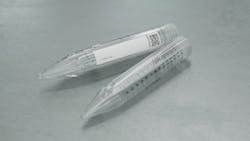In-mold labeling for medical parts shown at Fakuma
By Karen Hanna
In-mold labeling (IML) — an option popular among packaging makers — got the clean-room treatment as a team of five manufacturers last month put on display the results of their efforts to find a better approach to labeling medical parts.
“We believe that in a more complex world — with more complex tasks — the answer is ‘collaboration.’ The difference is ‘the team’ that takes the customer requirement and solves it faster and better,” said Johannes Strassner, managing director and chief sales officer for Kebo.
As part of the collaboration, at Arburg’s Fakuma booth, Arburg showed off an electric Allrounder A Ultimate injection molding machine (IMM) equipped with IML capabilities. The molding cell combined an eight-cavity IML mold from Kebo, inspection system from Intravis, labels from label specialist Multi-Color Corp. (MCC) and automation from Beck Automation.
With clamping forces of around 9 tons, the IMM produced 15 mL centrifuge tubes from PP, according to a press release from Arburg.
A press release from Kebo said the highly integrated IML system was designed to achieve maximum precision with top gate quality and minimum core shifts; ensure the production of high-quality parts; use labels that meet stringent legal requirements and industry standards; and offer accuracy and repeatability in label positioning.
Medical molders don’t use IML as much as packaging makers, but an Intravis press release laid out the advantages: “Self-adhesive labels can be peeled off or replaced, while authenticity can be safely guaranteed via IML. IML of the latest generation, in conjunction with intelligent downstream systems, maps the complete manufacturing process of a product. … The logistical and space requirements are reduced, as is the risk of contamination.”
MCC can supply labels that provide features such as temperature indicators and unique codes for tracking and traceability.
With an advanced vision inspection system from Intravis, the IML cell on display at Fakuma produced parts with real-time inspection and rejection — a process that can ensure regulatory and legal compliance as well as patient safety. That allows users to make fixes on the fly, as deviations are detected.
Among other benefits, Arburg said the compact Fakuma cell achieved energy efficiency and represented a small carbon footprint.
Strassner said the technology comes out as customers have approached Kebo for labeling improvements, including enhanced functionality and safety and better haptic qualities.
In an email, he provided credit to each partner for its contribution to the cell, saying, “Thanks to improved mold technology (Kebo), we were able to optimize the wall thickness distribution and thus the accuracy for label positioning. Thanks to a patented label head adjustment system (Beck), we were able to significantly improve the positioning accuracy of the labels. Using an innovative die-cutting technology (MCC Verstraete) for medical labels, we were able to significantly improve the print-to-cut tolerance of the labels. By using the Intravis LabelWatcher, we ensure 100 percent quality control.”
Karen Hanna, senior staff reporter
Contact:
Arburg Inc., Rocky Hill, Conn., 860-667-6500, www.arburg.com
Beck Automation AG, Oberengstringen, Switzerland, 41-44-751-8448, www.beck-automation.com
Intravis Inc., Norcross, Ga., 770-662-5458, www.intravis.com
Kebo AG, Neuhausen, Switzerland, 41-52-674-1414, www.kebo.com
MCC, Batavia, Ohio, 513-943-0080, www.mcclabel.com
About the Author
Karen Hanna
Senior Staff Reporter
Senior Staff Reporter Karen Hanna covers injection molding, molds and tooling, processors, workforce and other topics, and writes features including In Other Words and Problem Solved for Plastics Machinery & Manufacturing, Plastics Recycling and The Journal of Blow Molding. She has more than 15 years of experience in daily and magazine journalism.
